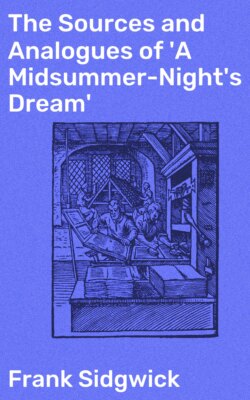Читать книгу The Sources and Analogues of 'A Midsummer-Night's Dream' - Sidgwick Frank - Страница 6
На сайте Литреса книга снята с продажи.
Footnotes
ОглавлениеTable of Contents
1
For
The Knightes Tale
, see Prof. Skeat's edition (modern spelling) in the "King's Classics," and his excellent introduction.
2
was named
3
realm
4
called
5
were not
6
besieged
7
See Mr. R.B. McKerrow's note on Nashe's reference to the name in
Have with You to Saffron-Walden
(
Works,
iii. 111).
8
See Statius,
Thebais
, I, 13–14, etc. (Chaucer refers to "Stace of Thebes,"
Knightes Tale
, 1436.) Athamas, having incurred the wrath of Hera, was seized with madness, and slew his son Learchus. His wife Ino threw herself, with his other son Melicertes, into the sea, and both were changed into sea-deities, Ino becoming Leucothea, and Melicertes Palaemon, whom the Greeks held to be friendly to the shipwrecked. The Romans identified him with Portunus, the protector of harbours.
9
See Skeat's
The Knight's Tale
, xi-xv.
10
little.
11
In this passage, Statius describes the meeting between Theseus, returning in triumph with Hippolyta, and the widows of those slain at the siege of Thebes, who complain that the tyrant Creon will not permit their husbands' bodies to be either burned or buried. This episode, as we shall see, is the opening of the
Knightes Tale,
and reappears in a modified form in
The Two Noble Kinsmen.
12
J. M. Rigg's introduction to his translation of the
Decameron
(1903)
13
This opening, derived from Statius (see note, p. 13), serves merely to introduce the main story, much in the same way as the Theseus story in
A Midsummer-Night's Dream
is simply the "enveloping action" of the play.
14
W.W. Greg's edition, i 19–20, ii. 168. Henslowe's dates for the performances are 17 September, 16 and 27 October, and November, 1594. Against the first entry are the much-discussed letters "ne," which appear to mark a new play. It will be seen that according to the theory that
A Midsummer-Night's Dream
belongs to the winter of 1594–5, this Palamon and Arcite play was performed immediately before.
15
Professor Gollancz considers that Shakespeare had no hand in the play.
16
Cf. I. i. 167 and IV. i. 129–30.
17
It is perhaps fantastic to interpret too literally Arcite's song to May—"I hope that I som grene gete may"—but, however little of their primitive significance now remains, celebration of the rites of May is by no means extinct. See E.K. Chambers,
The Mediaeval Stage
, I. 117: "their object is to secure the beneficent influence of the fertilization spirit by bringing the persons or places to be benefited into direct contact with the physical embodiment of that spirit."
Shakespeare's apparent confusion of a May-day with a Mid-summer-night may seem pardonable to the folk-lorist in the light of the fact that various folk-festivals appear to take place indiscriminately on May-day or Midsummer-day. See Chambers, op. cit. i. 114, 118, 126.
18
Cf. III. ii. 331 and 401,
etc
.
19
Cf. IV. i. 100–183.
20
In V. i. 51.
